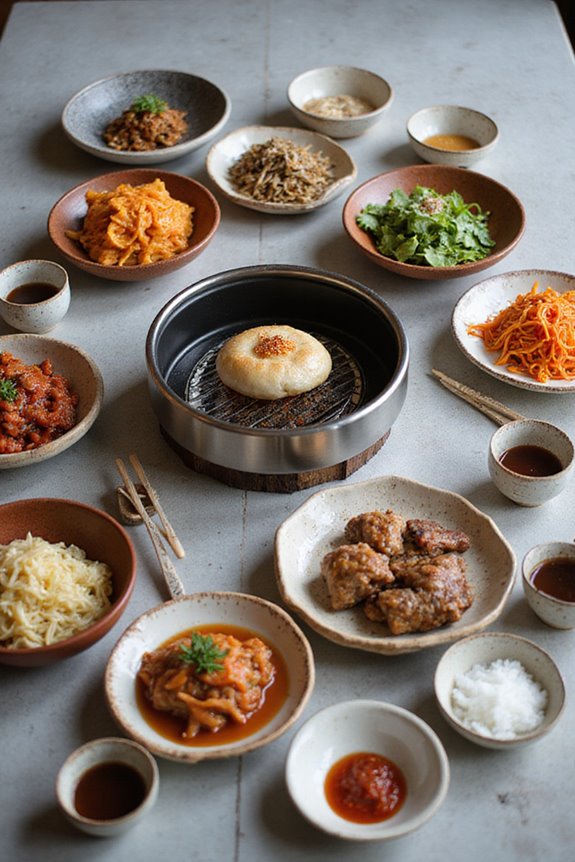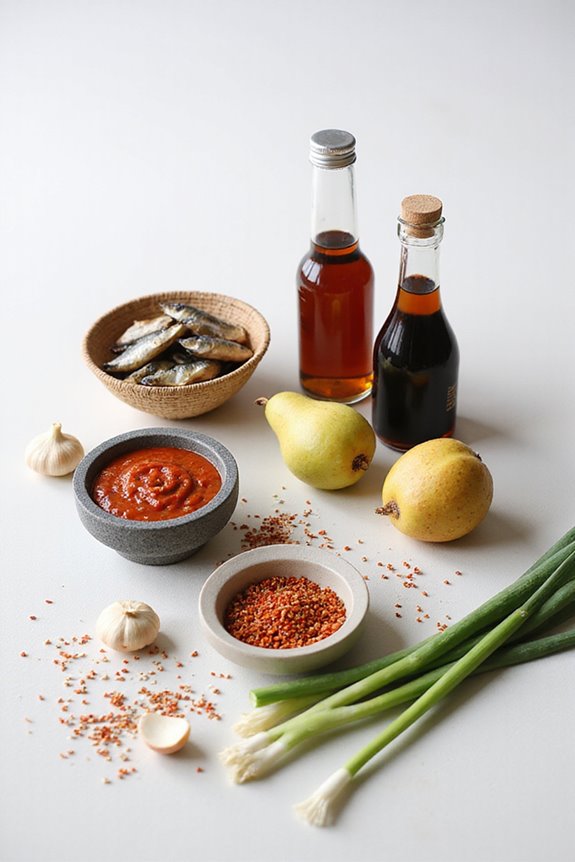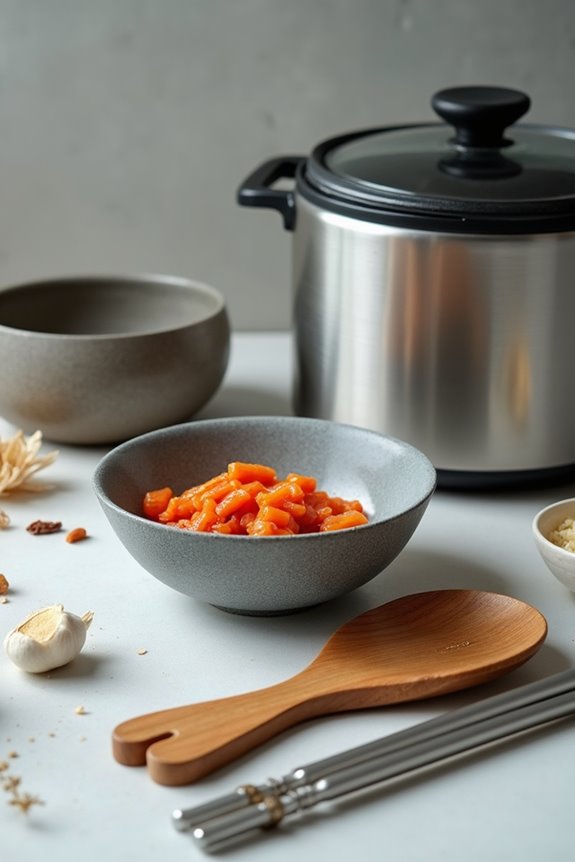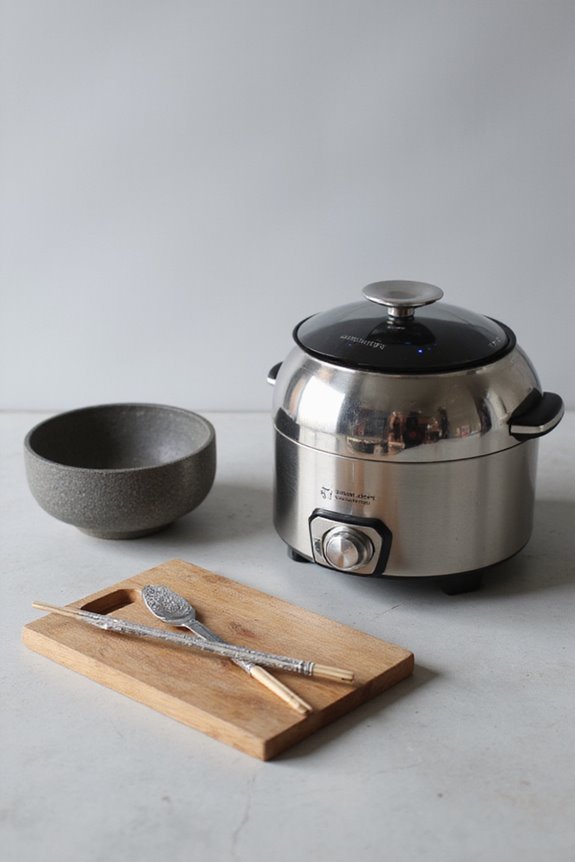To host a Korean food party, we should focus on sourcing authentic ingredients, like those from local markets or Korean supermarkets. Selecting a diverse menu is essential; popular options include kimchi, bulgogi, and bibimbap, alongside vegetarian dishes like vegan kimchi. We can enhance the experience with interactive dining stations for DIY bibimbap or Korean BBQ. Creating an inviting ambiance through traditional decor and engaging entertainment, such as K-pop music, will elevate the event. There’s much more to explore for successful planning.
Key Takeaways
- Source authentic ingredients from local markets and Korean supermarkets to ensure traditional flavors in your dishes.
- Create a diverse menu featuring beloved Korean dishes while accommodating dietary restrictions with vegetarian or vegan options.
- Set up interactive dining experiences, like DIY bibimbap stations and hands-on cooking methods, to engage guests.
- Enhance the atmosphere with Korean-inspired decor, ambient lighting, and cozy seating arrangements for a welcoming environment.
- Provide memorable takeaways, such as homemade kimchi jars or recipe cards, to leave a lasting impression on your guests.
Planning and Preparation
When we start planning a Korean food party, early preparation serves as a crucial aspect that can greatly reduce last-minute stress. First, we should focus on ingredient sourcing, prioritizing local markets and Korean supermarkets for authentic, fresh options. Using seasonal ingredients not only enhances the quality of our dishes but also aligns with current trends in sustainable cooking. Additionally, understanding guest preferences is important; identifying any dietary restrictions early on helps us cater to everyone’s needs. We can offer options such as vegetarian or vegan dishes to promote inclusivity. Overall, by planning ahead and considering our guests’ tastes, we create a well-organized and enjoyable atmosphere that enhances the overall experience of the food party. Incorporating authentic Korean ingredients will elevate our dishes and ensure a true taste of Korean cuisine.
Menu Selection
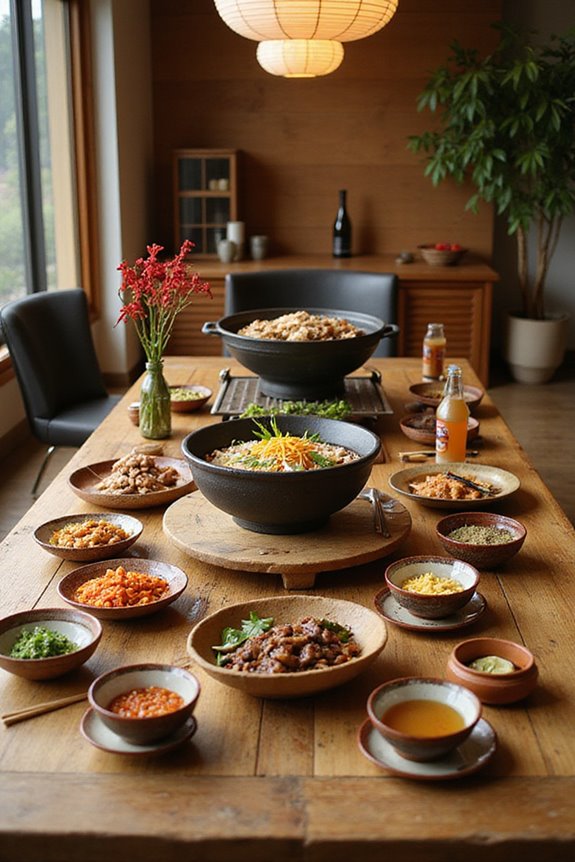
A well-thought-out menu is essential for creating an enjoyable Korean food party, guiding our choices to suit diverse palates and dietary preferences. We can consider various menu themes, such as traditional dishes, modern favorites, or seasonal offerings. For instance, pairing Korean BBQ, like bulgogi, with hearty banchan enhances the overall experience. Including vegetarian options, such as vegan kimchi and stuffed bell peppers, guarantees inclusivity for plant-based guests. Additionally, suggesting an interactive station for DIY bibimbap can engage attendees while allowing them to personalize their meal. Finally, offering a selection of desserts, particularly Patbingsu, can be a delightful way to conclude the feast, accommodating all guests, regardless of dietary restrictions or taste preferences. Using premium lead-free clay for cooking pots enhances the authenticity of the dishes served.
Decor and Ambiance
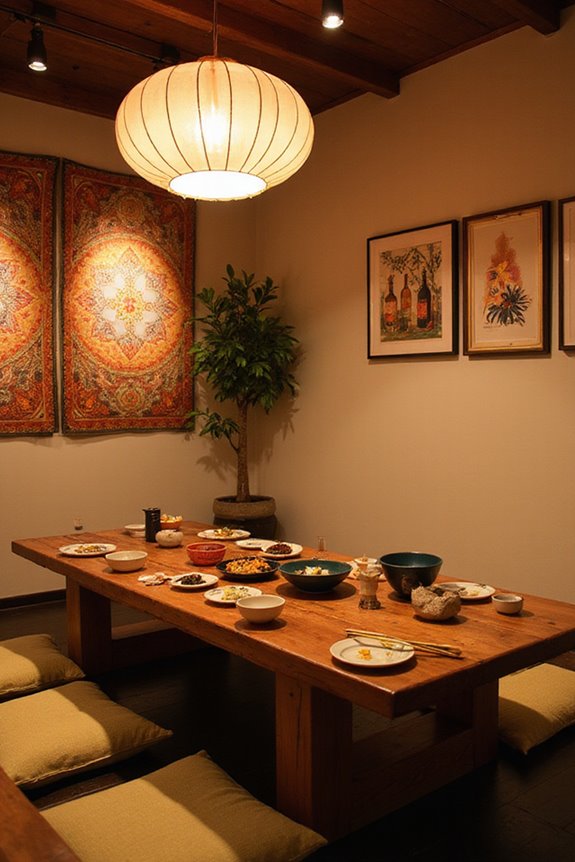
Creating the right decor and ambiance will enhance our Korean food party, making it a memorable experience for all guests. Traditional decor styles, like exposed wooden beams and Hanji accents, can ground our space in authentic Korean heritage. Using wooden furniture in dark tones adds simplicity and harmony, while decorative accents—such as Korean lamps—transition beautifully into modern settings. For lighting options, adjustable pendant lights or stylish chandeliers can provide elegance, ensuring warm, inviting spaces. Implementing ambient lighting, like cove and accent lights, enhances visual appeal and highlights cultural details. A blend of industrial materials, pastel walls, and cozy seating can also create a trendy yet welcoming atmosphere, appealing to various age groups and preferences among our guests.
Interactive Dining Experience
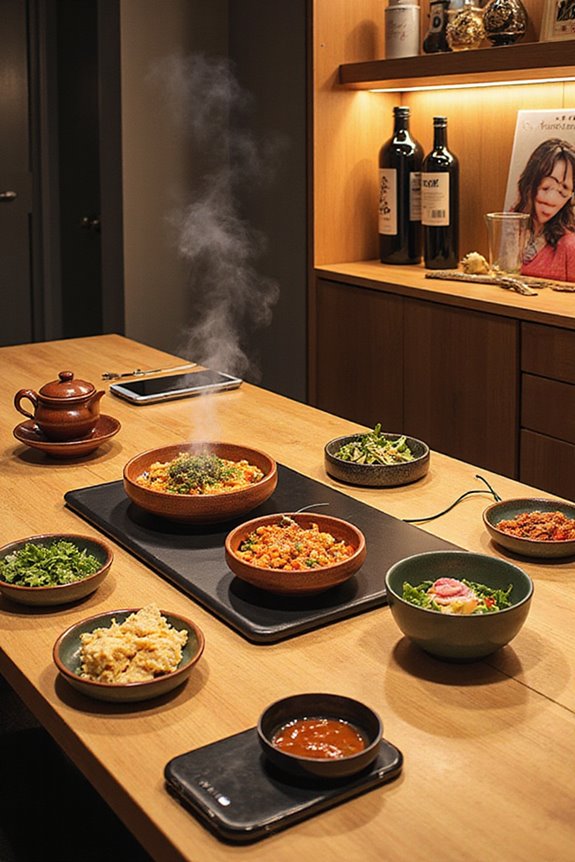
Incorporating an interactive dining experience greatly enhances the enjoyment of our Korean food party, allowing guests to actively participate in their meals. Setting up self-serve stations enables guests to build personalized bowls with rice cakes, noodles, and proteins while choosing from an array of sauces to adjust spice levels. Hands-on cooking methods, like Korean BBQ and hot pot, invite guests to grill meats or boil ingredients at the table, enhancing engagement. Additionally, we can prepare dishes like japchae and pancakes with guest participation, promoting a sense of authenticity. This collaborative cooking fosters conversation and community as everyone shares portions and passes around banchan, ensuring a dynamic and enjoyable atmosphere throughout the dining experience. Including a selection of Korean cooking sauces can elevate the flavors and create a memorable culinary adventure for all.
Cultural Significance
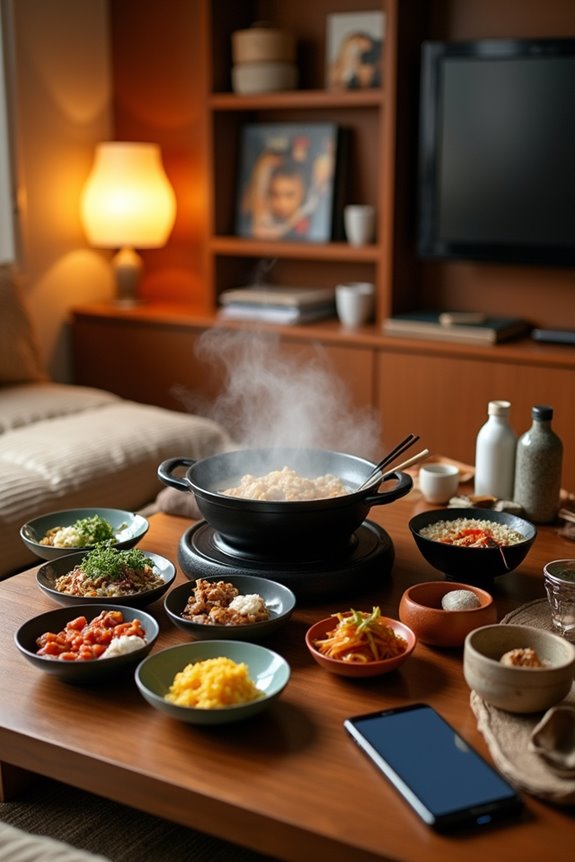
Understanding the cultural significance of Korean food deepens our appreciation for its rich heritage and communal nature. Korean cuisine acts as a bridge between family traditions and generations, with recipes often passed down through observation, embodying the essence of *son-mat*, or “flavored by hands.” Traditional dishes reflect a family’s identity and pride, highlighting the importance of shared meals. Communal experiences, such as Korean BBQ, go beyond sustenance, as they encourage social unity through interactive dining. Each meal, designed with balance among flavors and nutritional elements, promotes not only physical well-being but also emotional connections. Ultimately, these culinary practices illustrate the crucial role food plays in reinforcing family bonds and fostering collective memory, which is essential to Korean culture.
Timing and Logistics
When planning a Korean food party, it’s vital to manage timing and logistics effectively, as these elements directly impact the event’s overall success. First, we should outline scheduling details that include preparation, setup, and guest arrival times. Creating a detailed timeline helps guarantee everything runs smoothly. Our menu planning should accommodate preparation times for various dishes, emphasizing dishes that can be made ahead, such as kimchi. Effective vendor coordination is key; we need to liaise with suppliers for food and, if applicable, decorations or entertainment. Additionally, tracking RSVPs allows us to address any dietary needs early on, which further simplifies our venue setup. Ultimately, a clear approach to timing and logistics will enhance our guests’ overall experience. Utilizing a vacuum sealer can help preserve the freshness of prepared dishes until serving time.
Creating a Relaxed Atmosphere
Creating a relaxed atmosphere is essential for hosting a Korean food party, as it enhances guest enjoyment and fosters connection. To achieve this, we should prioritize our seating arrangements, opting for communal dining around low tables with cushions for comfort. This replicates traditional Korean meals and encourages closeness among guests. For our music selection, we can curate a playlist featuring traditional instrumental tracks or soft K-pop ballads, ensuring the volume remains moderate to facilitate conversation. Additionally, incorporating soft lighting elements, like paper lanterns, can create a warm, welcoming ambiance. By combining these elements, we lay the foundations for a cozy environment that encourages a shared dining experience, allowing everyone to relax and truly enjoy the meal together. Moreover, consider using unique design elements in your table setting to enhance the overall aesthetic and create a visually appealing dining experience.
Engaging With Guests
To foster a lively and memorable experience at our Korean food party, engaging with guests should be a top priority. Incorporating Yut Nori, a traditional Korean board game, can be an easy and entertaining way to encourage interaction. Setting up a mini karaoke station, featuring popular K-pop songs, allows guests to sing along, creating a vibrant atmosphere. We can also organize group challenges related to Korean culture, providing opportunities for collaborative fun. Additionally, sharing insights about Korean cuisine during dinner promotes intellectual engagement. By involving guests in hands-on cooking activities, like making Kimchi Jeon, we enhance their experience. Ultimately, a variety of culturally immersive activities will keep our guests actively involved and enjoying the evening. To further enhance the experience, consider offering Korean Drama Gifts like themed blankets or mugs, which can serve as great conversation starters and memorable takeaways.
Frequently Asked Questions
What Beverages Pair Well With Korean Food During Parties?
When we’re considering beverages for our Korean food parties, soju cocktails add a fun twist, while traditional teas provide a soothing contrast—both perfectly enhance the flavors of our favorite dishes and create a memorable experience.
How Do I Handle Food Allergies Among Guests?
We recognize handling food allergies can feel intimidating, but with proactive guest communication and effective allergy substitutions, we can create a safe and enjoyable experience for everyone, minimizing risks and maximizing comfort during our gatherings.
Can I Incorporate Non-Korean Dishes Into the Menu?
Absolutely, we can incorporate non-Korean dishes! By blending Korean fusion with international flavors, we create a cultural balance that enhances our menu, delights diverse palates, and guarantees a memorable experience for all our guests.
What Utensils and Dishes Are Essential for Serving Korean Food?
Gather ’round the table, where tradition meets delight! When serving Korean food, we’ll need traditional utensils like long-handled spoons and chopsticks, paired with thoughtful serving styles to showcase our delicious dishes and vibrant banchan.
How Can I Keep Dishes Warm During the Party?
To keep dishes warm during the party, we can use chafing dishes and heat lamps. They’ll guarantee everything stays at the perfect temperature, letting our guests enjoy every bite as if it’s freshly served.

